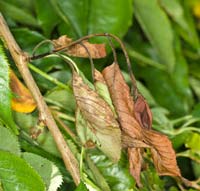Bacterial canker of plum and cherry - new report
By Steve Roberts, 05 Jul 2013
Bacterial canker is one of the most important disease of plums and cherries, affecting trees during nursery production, after planting, in fruit production, and in woodlands. In its most severe form it can kill trees. Fruit and amenity trees are usually propagated by chip-budding of scion varieties during summer onto stock-plants raised from cuttings taken in the previous autumn or autumn before. This presents particular challenges for the management of this difficult disease.
Bacterial canker can be caused by two distinct pathovars (pv.) of Pseudomonas syringae: pv. morsprunorum (Psm) and pv. syringae (Pss). Psm is host specific to Prunus species, whereas Pss has a much wider host range, with the potential for cross infection between a number of different species and genera. Although the stem canker phase is the most economically important, these pathogens also cause leaf spots/shot-holes, bud death, shoot die-back and flower blights. It is important to note that stem cankers result from infections which have been initiated in the previous year, and may not always be obvious in the first year after infection. Thus cankers may not be observed until 18 months after the initial infection has taken place.
Throughout the world, almost all previous work on control of bacterial canker has been targeted at orchard fruit production. As a result of on-going problems, the HDC HNS panel commissioned a 3 year project (2010-13) with Plant Health Solutions on the management of bacterial canker specifically targeting nursery production (HNS 179). The overall aim of the project was to identify management options which would be of benefit in the control of bacterial canker in plums and cherries. Extensive trials were done at two nurseries to look at leaf and bud populations of the two pathogens on plums and cherries throughout the year and to look at the effects of different spray treatment on those populations.
The full report is now available from the HDC website, and the project has been highlighted in Hortweek's Science into Practice section: Managing Bacterial Canker
Tags: plants; diseases; bacteria; bacterial canker; plums; cherries; Pseudomonas
